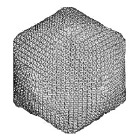Plant Pathology, Department of

James Van Etten Publications
ORCID IDs
Document Type
Article
Date of this Version
2014
Citation
Virology 466–467 (October 2014; Special issue: Giant Viruses), pp. 103–111; doi: 10.1016/j.virol.2014.05.002
Abstract
Phycodnaviruses are dsDNA viruses, which infect algae. Their large genomes encode many gene products, like small K+ channels, with homologs in prokaryotes and eukaryotes. Screening for K+ channels revealed their abundance in viruses from fresh-water habitats. Recent sequencing of viruses from marine algae or from salt water in Antarctica revealed sequences with the predicted characteristics of K+ channels but with some unexpected features. Two genes encode either 78 or 79 amino acid proteins, which are the smallest known K+ channels. Also of interest is an unusual sequence in the canonical α-helixes in K+ channels. Structural prediction algorithms indicate that the new channels have the conserved α-helix folds but the algorithms failed to identify the expected transmembrane domains flanking the K+ channel pores. In spite of these unexpected properties electophysiological studies confirmed that the new proteins are functional K+ channels.


Comments
Copyright © 2014 Elsevier Inc. Used by permission.